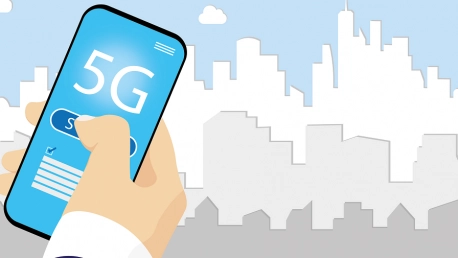The mid-band spectrum is essential for using the full potential of 5G technology and for the integration of Industry 4.0 usage scenarios in Europe. However, Europe is still lagging behind other regional markets in the deployment of 5G networks in the mid-band spectrum due to auction synchronicity and delayed investments.
Strong Signals from Service Providers
On average, national coverage in the mid-band spectrum for the 14 communications service providers covering Europe and the UK is less than 10% in 2021 and is expected to reach 15% in 2022. While the above suggests that Europe may not be able to keep up with its main global competitors, the determination and technological capabilities to do so exist. Recently, major European communications service providers such as Vodafone and Deutsche Telekom showed their intentions to step up investment in 5G technology in the coming years. In addition, we should not lose sight of the fact that research into 5G technology has originated in Europe. Research projects such as METIS 2020, funded by the European Union, have made significant contributions to the development of innovations, while early adopters of 5G, such as Switzerland and Poland, have demonstrated the huge potential of this technology.
However, in order to exploit this potential, Europe needs to build a robust 5G infrastructure and take into account the best practice models of its North American and North-East Asian partners, especially in terms of per capita network investment, while at the same time seeking to remove barriers to the deployment of mid-band spectrum 5G networks. To shape a digital Europe, the European Commission has developed the Connectivity Toolbox, a set of best practices through which operators can get access to the spectrum they need to develop 5G networks, thus encouraging them to continue investing in 5G technology.
In recent years, Ericsson has partnered with many of Europe’s largest industrial companies as well as various communications service providers to develop private 5G networks at manufacturing facilities, mines, ports, and airports or utility systems. These projects have demonstrated the ability of 5G technology to optimize industrial operations, but the impact has been limited, and in order to extend the benefits on a large scale, Europe needs mid-band spectrum to be made immediately available to operators for 5G services.
Europe Missed the Start of 4G Deployments 10 Years Ago
The current situation is similar to about 10 years ago when 4G was introduced. Even then, Europe missed the start of deployments and has never been able to catch up. As a result, Europe failed to penetrate the so-called “app economy” markets, which it had to abandon to competitors in North America or Northeast Asia.
Today, European communications service providers, constrained by the regulatory framework and a lack of financial incentives, are already lagging behind those in the US, South Korea, and China in the race for the revenue opportunities brought by 5G technology.
Accelerating 5G Networks Deployment
Accelerating the deployment and roll-out of 5G networks can help the EU to make the most of its full potential and access the economic and social benefits of this technology. An updated report by Analysys Mason, commissioned by Ericsson, estimates that the potential economic value of 5G technology, used as an ‘open innovation platform’, could add €250 billion to net GDP across the continent. Another report, commissioned by Vodafone and carried out by Deloitte, shows that if EU investment were used to ensure that every member state achieved a DESI score of 90 by 2027, then EU-wide GDP per capita would be 7.2% higher – equivalent to an overall increase of over €1 trillion.
The Digital Divide Between Europe and Global 5G Leaders
Without extensive implementation, Europe could face an increasing rate of inequality in digital connectivity in the future, and the digital divide we see today could widen significantly.
Western Europe, with a mobile 5G adoption rate of only 1%, ranks 4th globally in terms of 5G market maturity, far behind markets in North-East Asia (9%), North America (4%), and Gulf Cooperation Council member states (2%), the Ericsson Mobility Report shows.
However, the report also indicates that Europe will be able to catch up with these countries once implementation barriers are removed and investment is encouraged. Thus, by the end of 2026, Western Europe is expected to have the third-highest adoption rate of 5G services globally – at 69% – putting it ahead of today’s leaders in North-East Asia and just behind the Gulf Cooperation Council states and North America.
5G-enabled devices are already available, and there is increasing activity in both the consumer and enterprise segments of European markets. European communications service providers need a level playing field in the race for 5G revenue opportunities, and government support in this regard is critical.









